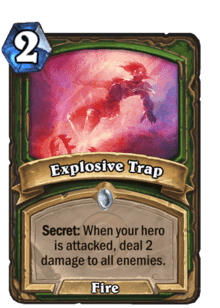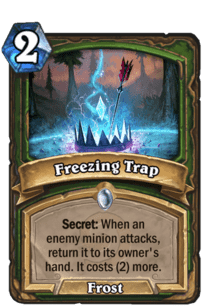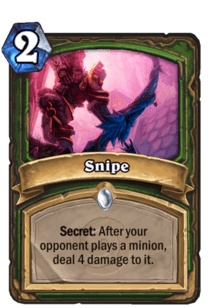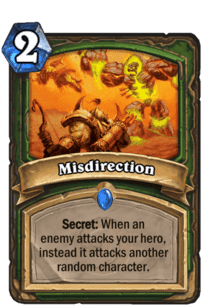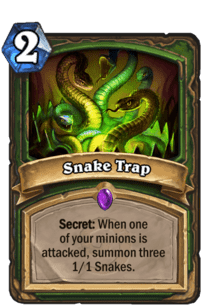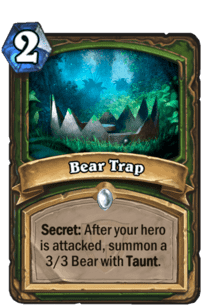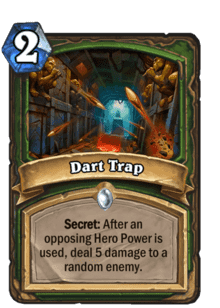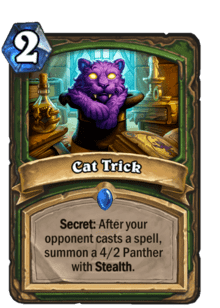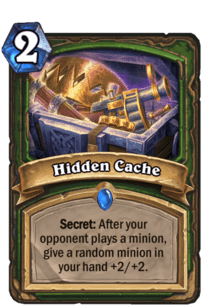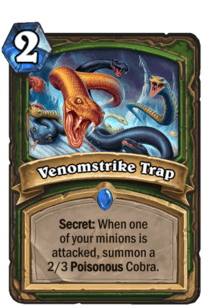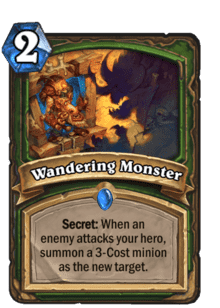Hunter Secrets
Table of Contents
Secrets are spells that, when played, place a buff on the casting hero. This buff remains active until a specific action occurs, at which point the Secret is triggered, causing its effect, and being consumed.
While your opponent can see when you play a Secret (the question mark icon that appears next to your hero's portrait will be visible to them as well as to you), they cannot see which Secret has been played. All Secrets have the same mana cost within each class, meaning that the amount of mana you used on the Secret cannot indicate to your opponent what Secret has been played.
While multiple Secrets can be active on a hero at the same time, only one instance of each Secret can be active at once.
It is important to note that Secrets can only be triggered during your opponent's turn.
This article will present the Secrets, their mechanics, as well as how to counter them and how to play them most efficiently.
Hunter Secrets and Their Mechanics
Hunters have access to 5 Secrets in the Standard format. All Hunter Secrets cost 2 Mana, and are marked by a green symbol when in play.
Secret Triggering Order
It is important to keep in mind that the order in which Secrets are played affects the order in which they trigger. Specifically, whenever two or more Secrets which can be triggered by the same action are in play at the same time, the Secret that was played first will trigger first.
Explosive Trap
Explosive Trap is triggered when the Hunter is attacked, dealing 2 damage to all enemy characters. Explosive Trap is triggered by all attacks from minions and heroes. Of note:
- The damage of Explosive Trap is increased by Spell Damage buffs.
- The minion whose attack triggers Explosive Trap will take the damage from Explosive Trap before dealing their damage to the Hunter. This means that if that any attacking minion killed by the Explosive Trap will deal no damage.
Freezing Trap
Freezing Trap is triggered when an enemy minion attacks, returning that minion to its owner's hand and increasing its cost by 2 Mana. As the wording implies, this effect is triggered regardless of what the target of the minion's attacks was. The minion is returned to the hand of the owner before it performs its attack, so the damage from that minion's attack is never dealt.
Snipe
Snipe is triggered when the Hunter's opponent plays a minion, dealing 4 damage to that minion.
The wording here is important. Snipe will only be triggered when the opponent plays a minion, meaning that any minion summoned by an effect does not cause Snipe to trigger. For example, Snipe does not trigger when a minion is summoned as a result of a spell or Hero Power (such as Shaman's Totemic Call or Paladin's Reinforce).
It is also important to note that the damage of Snipe happens after the minion's Battlecry, even if that Battlecry requires targeting. For example, if an Ironbeak Owl triggers Snipe, the Silence Battlecry will still occur before the Ironbeak Owl is killed.
Snipe will always deal damage to minions with Stealth. If Snipe hits a minion with Divine Shield, it will break the Divine Shield.
Misdirection
Misdirection is triggered when a character attacks the Hunter, causing it to attack a different random character instead. The effect is triggered by any attack, including attacks from minions and heroes. Misdirection is not triggered by Battlecries, spells, or Hero Powers, and will not trigger if an enemy hero attacks you while the board is empty on both sides.
When Misdirection is triggered, the attack will be redirected to any random character other than the Hunter or the enemy making the attack. This can include enemy minions, the enemy hero, or any minion belonging to the Hunter.
Snake Trap
Snake Trap is triggered when one of the Hunter's minions is attacked, summoning three 1/1 Snakes for the Hunter. Snake Trap is only triggered by attacks, and only by attacks made against the Hunter's minions.
Snake Trap will trigger if there is any open space on the Hunter's board for new minions, but it will not break the maximum limit of 7 minions per player. For example, if the Hunter has 5 minions on the board, only 2 Snakes will be summoned by Snake Trap.
Countering/Detecting Hunter Secrets
In order to play around your enemy's Hunter Secrets, you will need to determine the optimal order to perform the following actions:
- Attacking one of your opponent's minions with a weak minion to test for Freezing Trap and Snake Trap;
- Playing a weak minion or very strong minion to test for Snipe;
- Attacking the Hunter with a weak minion to test for Explosive Trap, Freezing Trap, and Misdirection.
Remember that these actions do not need to be performed in a specific order, as they depend heavily on the context of the current game.
Freezing Trap, Venomstrike Trap, and Snake Trap
Snake Trap is triggered by attacks made against minions, while Freezing Trap is triggered by all attacks. To minimize the impact of Freezing Trap, it is best to attack with a cheap minion first. As the trap will summon minions that do not get in the way of attacks, the only way to minimize its effects is to ensure that the minions it creates do not present serious problems for you.
With Snake Trap, it is best to wait until after you make attacks to use board clear effects. For example, if you have an Dread Infernal in your hand, you will be able to clean up the snakes which are created by either trap if you wait to play it until after your trigger these Secrets.
There are several Hunter cards that synergize with the Beasts that are created by Snake Trap, including Starving Buzzard and Scavenging Hyena. If one of these card is on your opponent's board while a Secret is active, it is probably best to kill or otherwise neutralize these cards with spells or Battlecry triggers (if possible) before attacking your opponent's minions.
Snipe
The easiest way to test for Snipe is to play a very cheap and weak minion, such as a Novice Engineer, so that you do not lose out on much if it dies. It is ideal if you play minions with Battlecries or Deathrattles, as you will always gain the value from their triggers. Another way to test for Snipe is to play a very strong minion which will
Explosive Trap, Freezing Trap, and Misdirection
Explosive Trap, Freezing Trap, and Misdirection are all triggered by attacks made against the Hunter, and can all be tested for at the same time.
Generally speaking, Misdirection is only played in defensive or spell-oriented Hunter decks, while Explosive Trap and Freezing Trap are played in a much wider variety of Hunter decks. Try to keep this in mind when testing for Hunter Secrets, as you are much more likely to run into Explosive Trap and Freezing Trap on the ladder.
There are a few things you can do to minimize the damage from Explosive Trap. First, you can attack your opponent's minions with all of own minions that have 2 or less health before attacking face. You can also be sure to test for Explosive Trap before playing any minions from your hand to avoid unnecessary minion damage.
For Misdirection, try to attack the Hunter with your weakest or least impactful minion first, as this will minimize the amount of damage that the Secret can cause.
Using Hunter Secrets Efficiently
Explosive Trap
Explosive Trap is most effective when being used to clear the board of enemy minions. This means that putting the Secret up when your opponent has few (or no) minions up is generally not a good idea. In general, playing Explosive Trap in the early or mid game is preferable, as this is when your opponent's minions will be most likely to die to it.
If you have no minions on the board and your opponent has many low-health minions (such as a group of Murlocs), it is best not to play any other minions until after Explosive Trap triggers. This is because your opponent will be able to trade their low health minions into your board before triggering the Secret, heavily neutralizing its effect.
Freezing Trap
Freezing Trap is best when it can be used to return a powerful or expensive minion to your opponent's hand. Sadly, it is generally quite easy for your opponent to play around Freezing Trap by attacking with a low-costing minion first. If your opponent has both powerful and weak minions on the board, it is probably best to wait on playing Freezing Trap unless you are under threat of lethal damage.
The best time to use Freezing Trap is when you have a good reason to believe that an important minion will be the first to attack you (such as when that minion is the only one on your opponent's side of the board). With that in mind, the best use of Freezing Trap is likely to be in the late in the game, or very early when playing against an Aggro deck. For example, if your opponent uses The Coin to play a Vicious Fledgling on turn 2, having that minion returned to their hand can lead to a tremendous tempo advantage.
Snipe
Snipe is a difficult Secret to play correctly, as it requires you to have an intimate understanding of the metagame to be use it properly. For example, if your opponent is playing a Midrange Hunter deck, Snipe is best played before your opponent can play their Bearshark on turn three. However, Snipe would not be a very strong play before your opponent's turn 3 against an Aggro Paladin, as they are likely to play a Rallying Blade or a 1-drop minion that turn. Try to predict what your opponent's next turn will look like before playing Snipe.
Misdirection
While Misdirection can be used to prevent damage to your hero, it is also worth considering that, with some luck, it can be used to kill one or more of your opponent's minions. If possible, the best time to use Misdirection is when your opponent has a small number of valuable minions on the board (and nothing else) while your side of the board is empty. In this sense, Misdirection is exceptional in that its best use is when you are far behind on board.
For example, if your opponent has a Chillwind Yeti and a Boulderfist Ogre on the board while you have nothing, then there are only a few outcomes which can occur. Either the Boulderfist Ogre and the Chillwind Yeti will deal their damage to each other (resulting in the Yeti's death), or the minion that attacked you will deal damage your opponent's hero. The worst case scenario here is that your opponent has taken 4 damage while you have avoided 4 damage, while in the best case scenario your opponent has lost their Chillwind Yeti, their Boulderfist Ogre has taken 4 damage, and you avoided some damage.
Snake Trap
Snake Trap is typically safe to play in any situation where it will be able to generate all 3 snakes (whenever you have four or fewer minions on the board), but it can also be used to generate some extra value for beast-matters cards such as Starving Buzzard and Scavenging Hyena. If you are ever able to play both Snake Trap and Scavenging Hyena, it might be best to wait on playing the Scavenging Hyena until after you have triggered the Snake Trap.
Wild Secrets
Bear Trap
Bear Trap is triggered when the Hunter is attacked, summoning a 3/3 Bear with Taunt for the Hunter. Bear Trap is triggered by all attacks from minions and heroes, but it is not triggered by any Battlecries, spells, or Hero Powers.
One important thing to mention is that the 3/3 Bear spawns after the attack is made against the Hunter, meaning that it will not be able to prevent the attack from occurring in the first place.
Bear Trap is a fairly straightforward Secret to use. The 3/3 Beast with Taunt that the Secret generates for 2 Mana is very efficient for its Mana cost, but is more effective in the early game than in the late game. Consequently, Bear Trap is a bit better to play early than late. The Beast generated by Bear Trap might also synergise with other beast-matters cards in your deck, but that is generally quite difficult to plan for and play around.
All in all, Bear Trap is a Secret that should be played whenever possible, assuming you have no better alternative plays.
Dart Trap
Dart Trap is triggered when the Hunter's opponent uses their Hero Power. This causes Dart Trap to deal 5 damage to a random enemy.
Dart Trap is the only secret which is triggered by a Hero Power being used, so it is easy to test for if you suspect it is in play. If you cannot afford to have 5 damage be dealt to your face or to one of your minions, try to avoid using your Hero Power until you can provide some potential targets to Dart Trap that are favorable for you, such as a minions with Battlecry abilities (like Novice Engineer) or minions with Divine Shield.
In aggressive Hunter decks, the Hunter will often want the 5 damage from Dart Trap to be dealt to face instead of a minion. 5 damage for 2 Mana is very efficient for Hunters, so it is often wise to mitigate this damage against aggressive decks by playing some of your weaker minions to the board before using your Hero Power. Alternatively, if you are also playing as an aggressive deck and feel as though board control is more important to your game plan than your life total, try to use your Hero Power first, before playing any minions, so you can tank the 5 damage to the face.
As your opponents will generally have quite a bit of control over when they use their Hero Powers, Dart Trap does not require very much finesse to play. If you want to maximize the chances that Dart Trap lands on your opponent's face, try to play it early and on an empty board. If you want to maximize the chances that it gives you board control, try to play it when your opponent has a small number of suitable targets on board.
Wandering Monster
Wandering Monster is a fairly straightforward Secret to use, as there are very few situations where this Secret will be ineffective. It will either gobble up one of your opponent's weaker minions, or neutralize an attack from one of their stronger minions. It is probably best to just play Wandering Monster whenever you have the spare Mana.
Venomstrike Trap
Venomstrike Trap is most effective when it can be used to trade with one of your opponent's strongest minions. As it costs just 2 Mana to play, you will come out ahead with Venomstrike Trap whenever the 2/3 Poisonous Cobra is able to trade with a minion that costs 3 or more Mana. For this reason, it is probably best to wait on casting Venomstrike Trap until you are reasonably sure that your opponent will be unable to kill the Cobra with a cheap spell or minion.
Cat Trick
Since it is very difficult to counter Cat Trick, playing the card does not really require precise timing or preparation. The worst outcome possible will be if your opponent can trigger the Secret and kill the Cat in a Hat on the same turn (essentially by using 2 spells, most likely), but this can rarely be avoided. Since there is very little counter play to Cat Trick, it is typically the best Secret to play on turn 2.
Hidden Cache
Try to play the minions you would rather not have buffed by Hidden Cache before playing it, as there are many minions which benefit more from Hidden Cache than others. For example, Bearshark and Dispatch Kodo will benefit much more from Hidden Cache than Alleycat will.
Changelog
- 10 Apr. 2019: Guide has been re-organised to reflect Standard Secrets in the Year of the Dragon.
- 29 Dec. 2017: Updated to add Venomstrike Trap and Wandering Monster.
- 07 Dec. 2016: Added Hidden Cache to the list of Secrets.
- 06 Sep. 2016: Added Cat Trick to the list of Secrets.
- 05 Jul. 2016: Clarified the order in which Secrets are triggered and cleaned up some confusing sections of the guide.
- 10 Dec. 2015: Added Dart Trap to the list of Secrets.
- 23 Aug. 2015: Added Bear Trap to the list of Secrets.
- 26 Aug. 2014: Added a mention that Secrets can only be triggered on the opponent's turn.
- Hearthstone Brings StarCraft and Major Updates in 2025
- Blizzard at Gamescom 2024
- Icy Veins Seeking Writers for Zenless Zone Zero: Apply Today!
- No BlizzCon in 2024
- Blizzard Games Return to China: New Agreement Signed With NetEase
- Blizzard Reportedly Reuniting with NetEase to Bring Back WoW in China
- Ex-Activision Blizzard CEO Bobby Kotick Shows Interest in Buying TikTok
- Timeline of Blizzard Presidents
